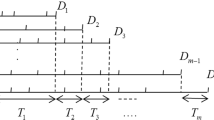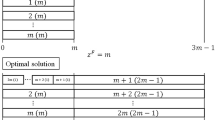Abstract
This paper deals with a parallel machine scheduling problem whose objective is to minimize a regular step total cost function. A real world application of the problem is presented, and Mixed Integer Linear Programming models are described for the cases with and without release dates, as well as a dedicated constraint generation procedure. Experimental results are reported and discussed to evaluate the relevance of the different approaches on well-known special cases and the general case.
Similar content being viewed by others
References
Baptiste, Ph., Le Pape, C., & Nuijten, W. (1999). Satisfiability tests and time-bound adjustments for cumulative scheduling problems. Annals of Operations Research, 92(0), 305–333.
Baptiste, P., Peridy, L., & Pinson, E. (2003). A branch and bound to minimize the number of late jobs on a single machine with release time constraints. European Journal of Operational Research, 144, 1–11.
Bornstein, C. T., Alcoforado, L. F., & Maculan, N. (2005). A graph-oriented approach for the minimization of the number of late jobs for the parallel machines scheduling problem. European Journal of Operational Research, 165, 649–656.
Bousetta, A., & Cross, A. (2005). Adaptative sampling methodology for in-line defect inspection. In IEEE/SEMI advanced manufacturing conference (pp. 25–31).
Brucker, P. (2007). Scheduling algorithms. Berlin: Springer.
Carlier, J. (1982). The one-machine sequencing problem. European Journal of Operational Research, 11, 42–47.
Chang, P. C., & Su, L. H. (2001). Scheduling n jobs on one machine to minimize the maximum lateness with a minimum number of tardy jobs. Computers and Industrial Engineering, 40, 349–360.
Chen, C.-L. (2008). An iterated local search for unrelated parallel machines problem with unequal ready times. In IEEE international conference on automation and logistics, Qingdao, China (pp. 2044–2047).
Dauzère-Pérès, S., & Sevaux, M. (2002). Using Lagrangean relaxation to minimize the weighted number of late jobs on a single machine. Naval Research Logistics, 50, 273–288.
Dauzère-Pérès, S., & Sevaux, M. (2004). An exact method to minimize the number of tardy jobs in single machine scheduling. Journal of Scheduling, 7, 405–420.
Garey, M. R., & Johnson, D. S. (1979). Computers and intractability: a guide to the theory of NP completeness. San Francisco: Freeman.
Good, R., & Purdy, M. (2007). An MILP approach to wafer sampling and selection. IEEE Transactions on Semiconductor Manufacturing, 20(4), 400–407.
Graham, R. L., Lawler, E. L., Lenstra, J. K., & Rinnooy Kan, A. H. G. (1979). Optimization and approximation in deterministic sequencing and scheduling: a survey. Annals of Discrete Mathematics, 4, 287–326.
Jackson, J. R. (1955). Scheduling a production line to minimize maximum tardiness (Research Report 43). Management Science Research Project. University of California, Los Angeles.
Jouglet, A., Savourey, D., Carlier, J., & Baptiste, P. (2008). Dominance-based heuristics for one-machine total cost scheduling problems. European Journal of Operational Research, 184, 879–899.
Lee, S. B., Lee, T.-Y., Liao, J., & Chang, Y.-C. (2003). A capacity-dependence dynamic sampling strategy. In Proceedings of the international symposium on semiconductor manufacturing conference (pp. 312–314). Berlin: Springer.
Leung, J. Y.-T. (Ed.) (2004). Handbook of scheduling: algorithms, models, and performance analysis. London/Boca Raton: Chapman & Hall/CRC.
Lopez, P., Erschler, J., & Esquirol, P. (1992). Ordonnancement de tâches sous contraintes: une approche énergétique. Automatique, Productique, Informatique Industrielle, 26, 453–481.
Meral, A., & Omer, K. (1999). Scheduling jobs on unrelated parallel machines to minimize regular total cost functions. IIE Transactions, 31, 153–159.
M’Hallah, R., & Bulfin, R. L. (2005). Minimizing the weighted number of tardy jobs on parallel processors. European Journal of Operational Research, 160, 471–484.
Moore, J. M. (1968). An n job, one machine sequencing algorithm for minimizing the number of late jobs. Management Science, 15, 102–109.
Pinedo, M. L. (2005). Scheduling: theory, algorithms, and systems. Berlin: Springer.
Tanaka, S., & Fujikama, S. (2008). An efficient exact algorithm for general single-machine scheduling with machine idle time. In IEEE international conference on automation science and engineering (pp. 371–376).
Van den Akker, J. M., Hoogeveen, J. A., & Van de Velde, S. L. (1999). Parallel machine scheduling by column generation. Operations Research, 47, 862–872.
Author information
Authors and Affiliations
Corresponding author
Additional information
An erratum to this article can be found at http://dx.doi.org/10.1007/s10951-011-0250-0
Rights and permissions
About this article
Cite this article
Detienne, B., Dauzère-Pérès, S. & Yugma, C. Scheduling jobs on parallel machines to minimize a regular step total cost function. J Sched 14, 523–538 (2011). https://doi.org/10.1007/s10951-010-0203-z
Published:
Issue Date:
DOI: https://doi.org/10.1007/s10951-010-0203-z




